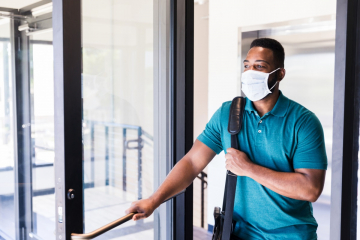The business world at large is in a disorienting state of limbo. Some of us are working from home, others are back at the office. Some expect to be back at the office soon while others are content to continue working from home.
For EHS leaders, this ambiguity is hard to navigate. In many ways, this hybrid dynamic is even more complex than dealing with the demands of a workforce that’s fully remote.
But we need to start approaching this split workforce as if it’s the new standard, because, as the data shows, it likely is.
The New Shape of the Workforce
Now is the time for EHS professionals to prepare for meeting the demands of a hybrid workplace that’s split between remote and on-premise work. For those that set their organizations up for success, there’s an opportunity to truly meet employees where they want to be, and improve wellness and productivity beyond what was possible in the traditional office paradigm. You’re also equipping your company to be more agile and resilient — factors that have truly shown their merit during this past year.
An Antea Group survey showed that 29% of companies indicated that more than half of their workforce will likely work from home permanently.
For those employees that want and are functionally able to work from home, this new flexibility is exciting. But there are potential challenges along the way — challenges that EHS leaders are in a unique position to help solve.
Bringing a Hybrid Workforce Together
Throughout the pandemic, EHS leaders have worked hard to foster team spirit and reduce a sense of isolation across a newly remote workforce. That alone is no small task, but with the advent of the hybrid workplace, businesses are faced with having to create a sustainable, long-term sense of unity and equity between those who work remotely and those who are in-office.
Creating a sense of inclusion can go a long way when it comes to employee morale and seamless collaboration. This can mean encouraging people to log onto video-conferencing software with their personal devices for team-wide meetings, even if they’re in the office.
From a managerial standpoint, you’ll also want to be on the lookout for communication or collaboration gaps that can occur within a disparate team. A passing conversation in the office halls could end up being valuable info that gets passed over remote team members. This can be helped by encouraging your team to get in the habit of documenting relevant details in a messaging app or round-up email.
What can also help is ensuring that both in-person and remote workers are represented on projects and teams. (This goes for the EHS team, too!)
These initiatives and considerations might have normally fallen under the realm of other department managers or HR in the past, but creating a comfortable, safe and healthy work environment in this reshaped setting will require an all-hands effort. The experience and expertise of seasoned EHS experts is critical in navigating the moment.
Policy-setting in a New Era
The hybrid workplace can be a value-driver for companies, as employees are able to work more in accordance with their strengths. But in order for this new paradigm to thrive, EHS leaders need to build new, relevant policies to help guide expectations and avoid potential pitfalls.
We previously touched on how setting remote-friendly policies can help enable and sustain a remote workforce. To build the best version of the hybrid workplace, policies should consider neither work style (remote or in-office) as the “primary” or prioritized one. Even if your workforce is skewed towards one option, it’s best to aim toward flexibility since — as we’ve learned — circumstances can change in a hurry. Your EHS onboarding process should reflect this and be re-evaluated based on your company’s approach to the hybrid workplace.
This past year has brought about a renewed focus on employee wellness, and many EHS leaders and employees alike have learned a great deal about what it takes for people to thrive in a remote work setting. The key now is building out (or expanding) wellness policies that address ergonomics, flexibility in work hours, mental health resources, and more for both groups of employees.
Staying a Step Ahead
From this point forward, we’re charting new territory. Organizations are asking themselves questions that will define the future of their workplace. What’s the policy on employees being allowed to switch between in-office and remote? How can you be flexible but still address the realistic needs of the business? Most importantly, how can you prevent any single employee from feeling like they are on uneven ground in terms of work experience, health and safety, or advancement opportunities?
Answering these and other questions isn’t always easy, but taking the time and consideration to build a sustainable, agile, productive version of the hybrid workplace will pay dividends — for your employees and your organization.
Want more news and insights like this?
Sign up for our monthly e-newsletter, The New Leaf. Our goal is to keep you updated, educated, and even a bit entertained as it relates to all things EHS and sustainability.
Get e-NewsletterHave any questions?
Contact us to discuss your environment, health, safety, and sustainability needs today.




